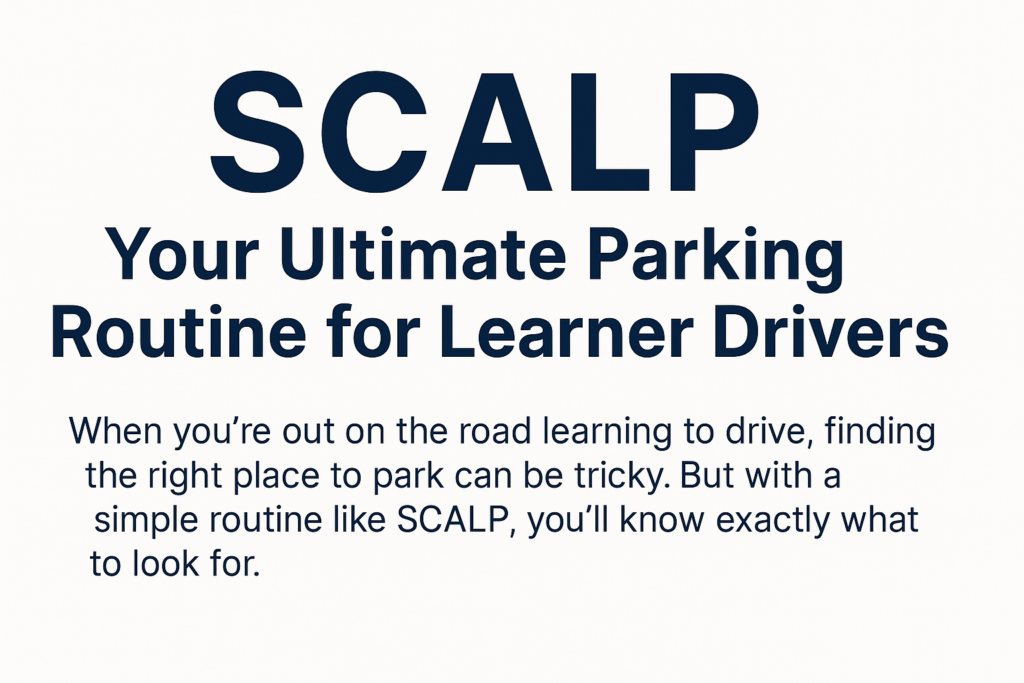
SCALP Routine: Your Ultimate Parking Method for Learner Drivers
When you’re out on the road learning to drive, finding the right place to park can be tricky. But with a simple routine like SCALP, you’ll know exactly what to look for. SCALP stands for Safe, Convenient, and Legal Parking — a perfect guide for learner drivers. Let’s break down the key points you should consider when deciding where to park.
Safe
The first thing to consider when choosing a place to park is safety. The location should be safe not only for you as the driver but also for other road users and pedestrians. Avoid parking in places that could obstruct traffic flow or put you in a potentially dangerous situation.
- Don’t park on corners or the brow of hills, as these areas can limit visibility and make it difficult for other drivers to see you or for you to see them.
- Look for areas where there is enough space for your car to be parked without blocking pathways or creating hazards for pedestrians.
Safety isn’t just about your own vehicle; think about the larger picture and ensure that parking in that spot won’t cause any unforeseen issues.
Convenient
Convenience is all about practicality. When choosing a parking spot, it should be easy to get into and out of, allowing for smooth manoeuvres. Parking in spots that are hard to access or require tricky turns will increase your stress, especially if you’re still getting used to parking.
- Clear views are essential — make sure you have a good view of the area around you when pulling into the space and when you’re ready to leave.
- Avoid tight, cluttered spaces where other cars are parked too closely. If you’re a beginner, wide spaces are your best friend.
Convenience also refers to how close the parking spot is to your destination. Ideally, you don’t want to park in a spot that requires a long walk. The closer, the better — but only if it meets the other SCALP criteria!
Legal
Parking legally is essential to avoid fines or having your car towed. Always ensure the space you park in is legal.
- Do not park over driveways or any areas that might block access to properties or businesses. Even if it seems like an empty spot, it could be private property, and parking there could cause problems.
- Be on the lookout for parking restrictions, such as double yellow lines or signs indicating no parking at certain times of the day. Even if the spot is empty, you can’t park there if it’s restricted.
Before you park, take a second to check for signs or road markings that indicate whether parking is allowed. If in doubt, it’s best to keep looking for a better spot.
Final Thoughts
By keeping the SCALP Routine in mind — Safe, Convenient, and Legal Parking — you’ll be able to choose the right place to park every time. Remember, a good parking spot isn’t just about fitting your car into a space; it’s about making sure the spot is safe for you, others, and legal. Practising these key points will help you feel more confident when parking, and over time, it will become second nature.
Safe driving and happy parking! 🚗💨
Tired of buses, lifts, and soggy walks?
Let’s get you driving! Whether you’re a newbie or just need a refresher, our calm, friendly instructors make learning stress-free (and even fun). No shouting, no pressure—just proper driving lessons at your pace.
Book your first lesson today and take the wheel of your freedom. Drive-thrus, road trips, and ditching the bus stop await!
Ace your Theory Test with driving theory test coach
Struggling to remember all the rules? We’ve got you! With quick lessons, realistic mock tests, and clever mnemonics, Driving Theory Test Coach makes learning simple and stress-free. Perfect for first-time learners or retakes, it’s everything you need in one website
